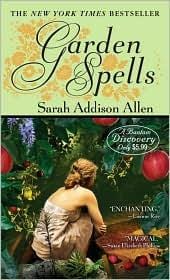Garden Spells: A Magical Realism Classic Worth Rediscovering
Discover the charm of Sarah Addison Allen's Garden Spells—an enchanting novel of family, food, and Southern magic that still blooms with relevance today.

Introduction to Garden Spells
Garden Spells by Sarah Addison Allen is a spellbinding novel that merges small-town Southern charm with delightful touches of magic. First published in 2007, the story has gained a devoted readership thanks to its evocative prose, enchanting characters, and themes of family, food, and second chances. Whether you are a long-time fan of magical realism or completely new to the genre, Garden Spells offers a gentle yet irresistible invitation to believe in everyday enchantment.
The Waverley Garden and Its Secrets
At the heart of Garden Spells lies an ancient garden tended by the Waverley women for generations. The apple tree at its center is said to be prophetic; anyone who bites into its fruit receives a vision of the most significant moment of their life. The herbs, edible flowers, and curious plants blooming around it also possess unique powers, from calming broken hearts to triggering spontaneous honesty. This living, breathing setting provides much more than background color—it shapes the plot, drives character decisions, and symbolizes the unexpected growth that springs from fertile ground.
The Power of the Enchanted Apple Tree
The apple tree in Garden Spells is almost a character in its own right. Its heavy branches fling fruit at unsuspecting visitors, determined to share revelations whether they are welcome or not. The tree’s cranky personality injects humor into the narrative while also reminding readers that enlightenment often carries a price. Just like life’s turning points, its apples can be sweet or painfully sharp, but they are always transformative.
Meet the Waverley Sisters
Claire Waverley, the eldest sister, is a caterer who infuses her dishes with botanicals from the family garden. Known for her self-imposed isolation, Claire prefers the steady predictability of her routines to the messy uncertainty of relationships. Her younger sister Sydney, by contrast, is a free spirit returning home after years on the run from an abusive marriage. Together, the sisters must learn how to heal old wounds, re-establish trust, and embrace the unconventional legacy that binds them.
Claire’s Culinary Magic
Claire’s cooking is more than mere sustenance; it becomes a vehicle for subtle emotional alchemy. Lavender‐laced lemonade inspires childhood nostalgia, candied violets summon courage, and rose-petal wine opens hearts to romance. By crafting menus tailored to her clients’ unspoken needs, Claire quietly shapes countless destinies. Readers who relish novels centered on food will savor every sensory detail poured into these scenes.
Sydney’s Journey of Self-Discovery
Sydney’s return to Bascom, North Carolina forces her to confront the shadows of a past she tried to outrun. She carries her daughter Bay, whose uncanny intuition warns her where things belong, hinting that the family magic will flourish in yet another generation. Sydney’s quest to reclaim her identity and protect her child adds depth and urgency to the narrative, illustrating how bravery often starts with a single homecoming.
Themes of Family, Forgiveness, and Authenticity
Garden Spells thrives on universal themes that resonate well beyond its fantasy premise. Chief among them is family—both the ties we inherit and the bonds we choose. The Waverley women, once scattered by fear and misunderstanding, discover that their shared roots are ultimately stronger than their differences.
Forgiveness is another cornerstone of the story. Claire must forgive Sydney for childhood betrayals, while Sydney must forgive herself for mistakes driven by desperation. The novel suggests that true healing blooms when we allow ourselves and others to start anew.
Finally, authenticity runs like a fragrant herbal thread throughout the book. Each character learns that embracing one’s quirks—be it prophetic cooking, intuitive interior design, or a cantankerous apple tree—is the surest path to fulfillment.
Symbolism in the Garden
The garden’s many plants act as living metaphors. Nasturtiums stand for hidden courage, rosemary for remembrance, and snapdragons for gracious strength. When characters ingest a flower or herb, its symbolic meaning often foreshadows forthcoming events. This botanical symbolism enriches rereads and invites reflection on how nature quietly mirrors human emotion.
Why Garden Spells Still Matters Today
Over a decade after its release, Garden Spells remains relevant for readers seeking hope in turbulent times. Its gentle magical realism offers escapism without detachment, grounding the extraordinary in relatable daily life. The focus on female empowerment, healthy love, and community support also aligns perfectly with modern conversations about resilience and self-care.
Moreover, Garden Spells celebrates southern culture without shying away from its complexities. The town of Bascom teems with gossip, tradition, and hospitality, creating a nuanced backdrop that feels authentic rather than caricatured. Readers who long for diverse portrayals of the American South will find Allen’s depiction refreshingly layered.
Reading Tips and Companion Treats
To fully immerse yourself in Garden Spells, consider pairing your reading session with a sensory treat inspired by the novel. Brew a cup of chamomile tea for tranquility or bake apple-cinnamon muffins to echo the orchard’s allure. If you enjoy listening to music while you read, soft acoustic folk tracks can enhance the novel’s wistful, intimate atmosphere.
Fans of Garden Spells may also appreciate companion books such as Like Water for Chocolate by Laura Esquivel, Chocolat by Joanne Harris, or Practical Magic by Alice Hoffman—all of which blend culinary or herbal magic with powerful storytelling.
Conclusion: Embrace the Everyday Magic
Garden Spells reminds us that magic is never far away; sometimes it hides in a backyard garden, a lovingly prepared meal, or the courage to start over. Through the intertwining lives of Claire, Sydney, and their colorful neighbors, Sarah Addison Allen invites readers to notice the subtle wonders growing in plain sight. Whether you pick up the novel for the first time or revisit it like a cherished recipe, you will likely close the book feeling nourished, hopeful, and attuned to life’s quiet enchantments.



